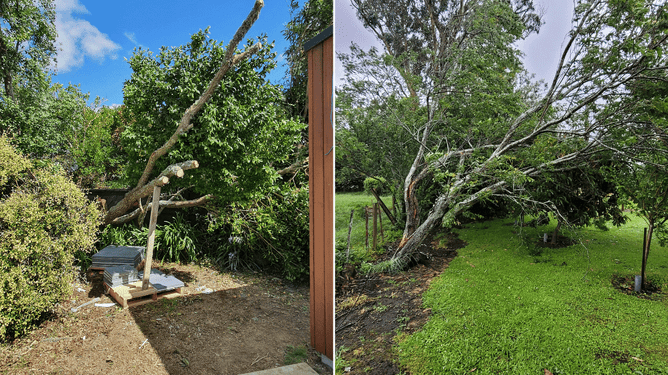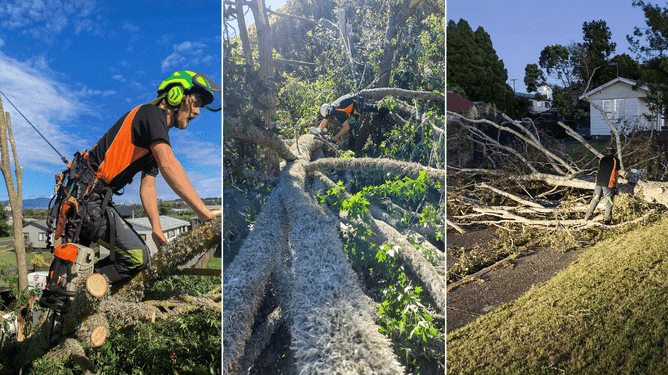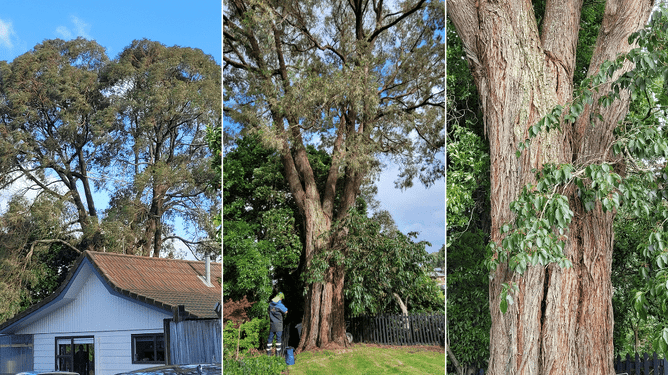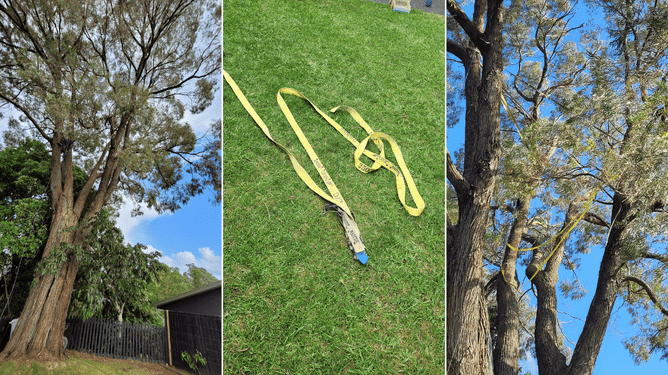New Zealand is experiencing more storms yearly. More wild weather equals more tree damage across the country. It is already happening, and we need to prepare more for them.
With more wild and unpredictable weather, it’s as essential for every property owner to understand how to check their trees before and after a storm.
We have prepared a quick storm-damaged tree checklist for property owners to refer to after experiencing tree damage.
Storm-Damaged Tree Checklist: What To Do After A Storm
1. Broken/Snapped Branches Hanging From The Tree
We often receive customer phone calls after a storm explaining that they have a big broken branch hanging from the tree.
It’s always better to let professionals remove the branch or the tree if unsafe, especially if the broken limb is high and requires overhead chainsaw work. Trees can act unpredictably, so please don’t tackle this job.
2. Sections Deadwood
Deadwood is effectively dead branches. Over time if they aren’t removed, they become heavier. This means that during a storm, they are most likely to break off and fall, causing damage to your property or public areas.
When cleaning up deadwood on the ground, look up before walking under the tree. You never know what could be overhanging and fall on your head at any moment.
3. Bark Inclusion
A bark inclusion is when a crack forms in the trunk of a tree. If no one notices the inclusion, a part of the tree, for example, a branch, may split.
After a storm, inclusion can appear because of the windy storm. It’s always easier to deal with the problem when the tree is young than waiting until it gets older.
If your tree already has an inclusion, but you notice fresh-looking tissues in the cracks, that means that the inclusion is worst than before.
There are many ways to prevent and manage the risk of tree splitting or branch falling.
A professional arborist can perform crown reduction pruning to alleviate the stress from a tree from the too-heavy branches.
Cabling and bracing: installing cables to secure the branches in place.
Tree removal is only a last resort when pruning and bracing aren’t an option, and the tree is a treat to the property and family living there.
4. Tree Roots
Always check around the base of the tree trunk to see if the ground level has changed.
The tree roots are affected if the ground level has gone up or down.
What To Do If Your Tree Has Fallen After A Storm
Waking up or arriving home to a fallen tree isn’t always something we expect. But if the tree has damaged your property or home, don’t worry. We are here to help.
Call us if you are unsure what to do and don’t have the proper equipment to clean up the fallen tree.
There are many hazards surrounding fallen trees.- Unstable root plates and trees
- Suspended limbs
- Branches leaning into other standing trees
- Uprooted trees
- Shattered tops of trees, which create hazards on the ground
- Heavy trees are leaning against other trees.
A professional and certified arborist has the knowledge and experience to clean up a fallen tree. Contact us to get professional help.
Tips On Safely Removing Trees (If You Have The Right Equipment And Knowledge)
Although, we understand that many property owners have the right equipment, such as chainsaws and PPE, to remove trees since they live on prominent properties and take care of their trees.
Here are some tips on safely removing trees if you have the right equipment, are aware of storms and have good size trees on your property.
Wear the proper Personal Protective Equipment (PPE): helmet, earmuffs, chaps or chainsaw pants, boots, gloves, eye protection, and visor.
Chainsaws are hazardous power tool because it doesn’t have an in-built safety feature. So make sure you know how to use a chainsaw, especially when cleaning up a tree. Don’t tackle it if you’re not used to it or aren’t doing it all the time.
Make sure you understand how to use a chainsaw and have the right tools to sharpen it. A blunt chainsaw is more dangerous than a sharp one!
Before cleaning up the area, ensure you have enough clear space to work, an escape route and clear communication in an emergency.
Reminding everyone to tackle this job only if they’re experienced is essential.
Otherwise, leave it to professional arborists with the experience, knowledge, and all the proper PPE and safety plan in place.
Storm-Damaged Tree: Tree Inclusion Case Study
We experienced a lot of rain and high winds in New Zealand two weeks ago. As a result, our team received a call from a concerned client on 24/11/2022 at 4:30 pm regarding their gum tree.
The team reacted quickly and went out to help. When Chris and Jesse arrived on-site, they noticed a significant inclusion in the gum tree. The arborists decided to strap the inclusion close to avoid the tree splitting or losing limbs. They used six ratchet straps to hold it together as a short-term solution.
In this case, we needed to strap the inclusion to make it safer because when you notice an inclusion in the tree, you never know how long it will be before it splits and hurts/kills someone. So, of course, the long-term solution will be to remove the tree, but we’re happy that no one was injured.
If you are concerned about the health of your trees, we can give you 30 free min of our time to assess your trees.



